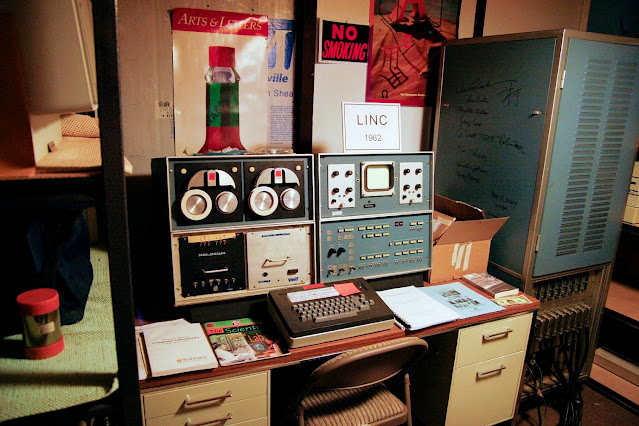First delivered in March 1962
The LINC – short for Laboratory INstrument Computer - was one of the world's very first minicomputers, helping to break the computer out of the corporate machine room and making it available to individual departments, labs and (at a stretch) homes.
Designed at MIT for academic work, most LINC machines were built by Digital Equipment Corporation, who were based in Massachusetts as is MIT. By 1962, DEC had already launched the PDP-1 (another candidate for the world’s first minicomputer) but the LINC was considerably cheaper and more compact.
Based on a 12-bit architecture, one innovation with the LINC was the tape drive (the LINCtape) which could store up to 400Kb and allowed a slow but reliable form of random access storage (somewhat like a very slow disk drive). The LINCtape evolved into DECtape, a common feature on DEC’s PDP line.
 |
| Digibarn's LINC system |
A small CRT could be used for output, and a rather clunky keyboard from Soroban Engineering (responsible for many computer keyboard of the same period) allowed input. Additional output could be made to a teletype, and the LINC could also be controlled by a set of rotary knobs which were essentially a precursor (pun intended) to the mouse.
The key application for the LINC was interfacing with lab equipment through the inbuilt A-to-D (analogue to digital) and D-to-A interfaces. This made the LINC a successful lab machine, although only 50 were built so it didn’t exactly change the world.
 |
| LINC exhibit at the Computer History Museum, California |
Significantly though, the LINC may be the world’s first home computer. Programmer Mary Allen Wilkes had a LINC system installed in her home, something that would be unfeasible with the 730kg PDP-1. It would take another 15 years or so before home computers became something that you could just go to the local electronics store to buy..
The LINC architecture grew into the PDP-5, PDP-8, PDP-12 and DECmate well into the 1970s. In the end though, the 16-bit PDP-11 and 32-bit VAX architecture (which were unrelated) moved things forward from there.
Image credits:
Jonathan Assink via Flickr - CC BY-ND 2.0
Don DeBold via Flickr – CC BY 2.0

No comments:
Post a Comment